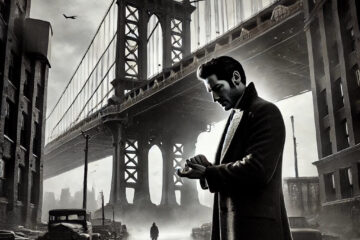Scene on the Hudson by Janie Alexander
Romanticism, an idea held during the Romantic Era or Romantic Period, was a movement that contained artistic, literary, and intellectual ideas. This occurred after the American Revolution, beginning in the 1790s and lasting well into the 1800s. People used romanticism to express their new ideas, freedom of speech, and nationalism. They were able to express a distinct American style of art and life through artwork, different genres of literature, and other rational ideas. Because the war was over, Americans were able to focus on much bigger and better things such as exporting their own art to other countries around the world.
Some artists would even travel to different countries to become educated in an international art school in order to receive and share new ideas and add more to their artistic knowledge. These new and improved romantic ideas would lead to a lot of thriving art in the coming years.
The painting “Scene on the Hudson” is a piece of art that portrays the three most important romantic ideas: nature, individualism, and emotion. Sitting alone, underneath what looks like a cave-shaped rock figure, is a small man with his dog and gun that rests upon a rock. Individualism is emphasized here because he is sitting alone, besides the little creatures hiding in the back, with a huge background surrounding him. It seems as if there is a spotlight shining on him to highlight that he is sitting alone demonstrating his independence. The variety of colors in this painting highlight the importance of nature and its beauty. There is much detail in the leaves falling from the trees and the calm waters in the background. They use dark warm colors to surround the man and cooler colors to show the water far in the distance. The artist may have used these colors to show emotions of adventure or perhaps they could be meant to show a sense of loneliness. The adventure is portrayed through the boats on the water. There is loneliness in this piece which is shown through the man who is portrayed as very small, trying to take on the big word alone.
The romantic movement fundamentally fit the American ethos as a young nation, embodying its ideals of freedom, nationalism, and independence.
Scene on the Hudson By Kennedy Mosley
From 1800-1861, a period called the romantic era was taking place. The romantic era was a reaction to the age of enlightenment in which artistic, literary, and intellectual movements affected the visual arts, music, and literature. During this time, people were more concerned with the individual rather than society, and it loosened the rules of artistic expression. The romantic era focused on nature and either portrayed it as sublime or horrific. Additionally, artists of the romantic era painted beautiful landscapes as a form of propaganda to promote European migration to the United States. Foreigners viewing such landscapes were meant to be
awe-inspired by the natural beauty of the United States and be inspired to travel great distances to view the spectacular scenes. This painting depicts a man sitting by himself in the woods. The tree’s part behind him showing the Hudson River, with mountains and boats. The painting, Scene on the Hudson, sells America as a beautiful, peaceful place and strives to get more people to travel to America.
Scene on the Hudson uses nature to show the calmness and beauty of America. During the romantic era, visual arts changed immensely as artists began to use nature to display beauty and tranquility. The romantic era was an optimistic era and loosened the rules to artistic expression. For example, artists would depict nature as sublime and emphasize the reality that man is small in the force of nature. Such styles of romantic era painting are present in the painting, Scene on the Hudson, as the artist used the trees to show stillness. The man in the painting is very small compared to everything else in the painting. This represents the nature over man theme that is present during the romantic era.
During the romantic era, artists also used color pallets to express emotion in a scene. In this specific painting, the artist used lighter browns and greens to make the trees. This shows that, although the man is in the forest and all alone, the man is still in the light. Before the romantic era, a man all alone in the forest would represent a scary, grim situation However, during the era, the loosened rules of artistic expression allowed artists were able to depict the forest as a calming, still, peaceful place. The painting, Scene on the Hudson, uses nature and color pallets to sell America as a calming, still place.
The Scene on the Hudson by Will Johnson
This picture at first looks plain and boring. However, this image has a much deeper meaning when you look at the details and realize what time period it is from. Let’s start with the time period the painting is from. The painting is from the Romantic time period. This time period was from 1800 to around 1850. Being a romantic style piece means it must hold certain details in the painting. The vastness of the land in the painting is a key element in romantic style art and its details. The individuality and aloneness in this painting are also key elements. The man is all by himself in a cave only accompanied only by his dog. However, if you look closely at the bottom left corner, there is something that resembles a person in the shadows. This small sort of detail shows how he is not truly alone. The man also has a heavenly light shining on him. Heavenly light is a part of the romantic style of art in a big way. It is one of the most crucial elements in the style of painting. The light breaking through the cave is simple, yet important part of the painting. It shows the symbol of hope because the light is sort of breaking through the darkness.
The details as well in this painting are very noticeable and very appealing. All the painting is outdoors, which is the biggest part of romantic style art. The outdoor concept allows all the other elements to come together and make the painting. If this was not outdoors, there would be no extreme vastness, natural beauty, or natural lighting. The outdoors also allows the effect of layers to come into play and allows the layers to show how vast this painting is.


